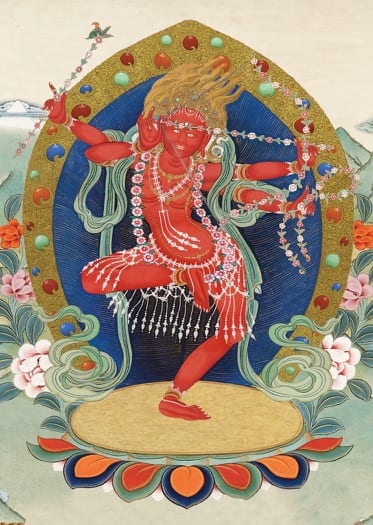Kurukulla is a powerful semi-wrathful female deity belonging to the Lotus family. She is a feminine embodiment of enlightened wisdom and is a dakini skilled in magnetizing everything required by the practitioner. Her magnetizing and increasing power attracts wisdom, happiness, health, wealth, and long life. Kurukulla is usually depicted as red in color, in dancing posture, and holding a flowery bow and arrow in one pair of hands and a hook and noose of flowers in the other pair.
There are over thirty-seven Kurukulla sādhana liturgies included in the Tengyur, and many more in the indigenous Tibetan literature.1https://read.84000.co/translation/UT22084-081-006.html Kurukulla is also one of the Twenty-One Taras mentioned in the ancient Tara tantras. She was assimilated into the Buddhist pantheon at least as early as the Hevajra Tantra, which contains her mantra.
Note on the Spelling of Her Name
Although her mantra addresses her as Kurukulle and not Kurukulla, that is a feature of Sanskrit grammar, addressing the deity in the vocative case as “Oh, Kurukulla”.
Her essence mantra is Oṃ Kurukulle Hrīḥ Svāhā (Tib. ༀ་ཀུ་རུ་ཀུ་ལླེ་ཧྲཱིཿསྭཱ་ཧཱ).
An Introduction to the Practice of Kurukulle
The natural state of all phenomena comprises the dharmakaya, sambhogakaya, and nirmanakaya. These three kayas manifest as the three roots of guru, yidam, and dakini. Therefore, the Vajrayana path greatly emphasizes the three roots. By practicing the three roots, one will be able to accomplish the three kayas.
Regarding the dakini, the third of the three roots, the wisdom dakini embodies innate wisdom, or the wisdom of dharmadhatu. As such, the dakini manifests in the sutra tradition as Prajnaparamita, the mother of all buddhas. In the tantric tradition, the dakini manifests as Vajrayogini.
The lineages of Chokgyur Lingpa and other great masters have innumerable profound sadhanas of Vajrayogini and other dakinis through which the practitioner can swiftly reach great realization. Within the tradition of Chokgyur Lingpa in particular, the dakini appears in dharmakaya, sambhogakaya, and nirmanakaya forms. Among these, the followers of the Chokling Tersar nowadays place great emphasis on the practice of the goddess Kurukulle, also known as Pema Dakini or Lotus Dakini. This practice belongs to the Seven Profound Cycles (Tib. Zabpa Kordün).
Within these, Guru Rinpoche taught four dakini practices to accomplish the four activities—namely, pacifying (Sitātapatrā, Tib. Dukkar), enriching (Mahāpratisarā, Tib. Sosor Drangma), magnetizing (Kurukulle, Tib. Pema Khandro), and subjugating (Vajraṇakhī, Tib. Dorjé Dermo). We engage in the magnetizing practice of Kurukulle through which we will be able to magnetize all the siddhis. Outwardly we’ll magnetize everything we wish for, inwardly we’ll magnetize our mind into the form of the deity, and secretly we’ll magnetize our mind into the innate nature.
Phakchok Rinpoche
For more information on Kurukulle practice, see:
Chokgyur Lingpa. Dakini Activity: The Dynamic Play of Awakening. Ed. Marcia Schmidt. Rangjung Yeshe Publications: Leggett, 2018.
And, for further teaching on Magnetizing Activity by Orgyen Tobgyal Rinpoche, see:
http://all-otr.org/vajrayana/38-magnetizing-activity-what-is-it-how-to-practise-it



